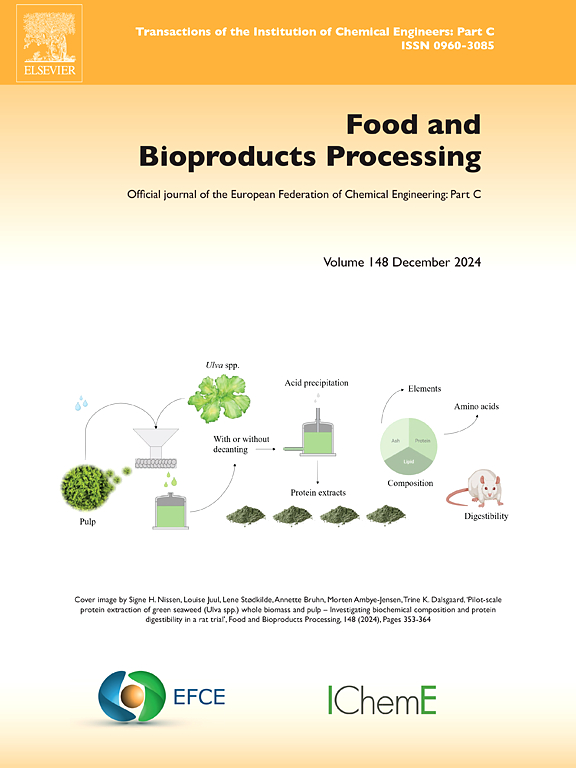Characterizing moisture content variation in pecan kernels under cold and hot water soaking treatments
IF 3.4
2区 农林科学
Q2 BIOTECHNOLOGY & APPLIED MICROBIOLOGY
引用次数: 0
Abstract
Each year, about 15 million pounds of pecan kernels are damaged during mechanical processing, reducing quality and yield by 30–50 %. Moisturization, an essential step in pecan processing, enhances cracking and shelling efficiency while minimizing waste. This process affects the mechanical properties of pecans, such as firmness and flexibility, ensuring kernels remain intact during cracking. This study investigates the effects of cold and hot bath conditioning methods on pecan moisture content, focusing on key variables like soaking time and water temperature. Cold water soaking was conducted at ambient room temperature (21°C) for durations ranging from 5 to 35 h, while hot water soaking utilized temperatures between 82°C and 93°C for 5–20 min. Statistical analyses, including regression models and ANOVA tests, were employed to develop predictive insights for achieving optimal moisture content. Regression analyses revealed distinct trends: cold water treatments allow uniform moisture absorption over extended durations, whereas hot water treatments achieve rapid absorption but with greater variability. Statistical models and ANOVA tests further identified key parameters and interactions influencing moisture outcomes, including the significant role of higher temperatures in the hot water method. These findings offer actionable recommendations for improving pecan processing efficiency, reducing costs, and enhancing product quality. The predictive moisture models presented in this study have not yet been validated against primary measurement techniques such as the oven-drying method. As such, the prediction error and deviation from standard reference values remain unquantified and are an important focus for future research. Future work will explore hybrid approaches combining hot and cold-water treatments. By optimizing moisture conditioning, this study contributes to reducing waste, aligning industry practices with sustainability goals, and meeting the growing demand for high-quality pecans in the global market.
冷热水浸泡处理下山核桃仁水分含量变化特征研究
每年,大约有1500万磅山核桃仁在机械加工过程中受损,质量和产量下降了30 - 50% %。保湿是山核桃加工过程中必不可少的一步,可以提高开裂和脱壳效率,同时最大限度地减少浪费。这个过程会影响山核桃的机械性能,如硬度和柔韧性,确保核仁在开裂时保持完整。本研究考察了冷水浴和热水浴调理方法对山核桃水分含量的影响,重点研究了浸泡时间和水温等关键变量。冷水浸泡在室温(21°C)下进行,持续时间为5至35 h,热水浸泡在82°C至93°C之间,持续时间为5 - 20 min。统计分析,包括回归模型和方差分析测试,用于开发预测见解,以实现最佳的水分含量。回归分析揭示了明显的趋势:冷水处理可以在较长时间内均匀吸收水分,而热水处理可以快速吸收水分,但变化较大。统计模型和方差分析进一步确定了影响湿度结果的关键参数和相互作用,包括高温在热水法中的重要作用。这些发现为提高山核桃加工效率、降低成本和提高产品质量提供了可行的建议。在这项研究中提出的预测水分模型尚未被验证针对主要的测量技术,如烘箱干燥法。因此,预测误差和与标准参考值的偏差仍然无法量化,这是未来研究的重要重点。未来的工作将探索结合热水和冷水处理的混合方法。通过优化水分调节,本研究有助于减少浪费,使行业实践与可持续发展目标保持一致,并满足全球市场对高品质山核桃日益增长的需求。
本文章由计算机程序翻译,如有差异,请以英文原文为准。
求助全文
约1分钟内获得全文
求助全文
来源期刊

Food and Bioproducts Processing
工程技术-工程:化工
CiteScore
9.70
自引率
4.30%
发文量
115
审稿时长
24 days
期刊介绍:
Official Journal of the European Federation of Chemical Engineering:
Part C
FBP aims to be the principal international journal for publication of high quality, original papers in the branches of engineering and science dedicated to the safe processing of biological products. It is the only journal to exploit the synergy between biotechnology, bioprocessing and food engineering.
Papers showing how research results can be used in engineering design, and accounts of experimental or theoretical research work bringing new perspectives to established principles, highlighting unsolved problems or indicating directions for future research, are particularly welcome. Contributions that deal with new developments in equipment or processes and that can be given quantitative expression are encouraged. The journal is especially interested in papers that extend the boundaries of food and bioproducts processing.
The journal has a strong emphasis on the interface between engineering and food or bioproducts. Papers that are not likely to be published are those:
• Primarily concerned with food formulation
• That use experimental design techniques to obtain response surfaces but gain little insight from them
• That are empirical and ignore established mechanistic models, e.g., empirical drying curves
• That are primarily concerned about sensory evaluation and colour
• Concern the extraction, encapsulation and/or antioxidant activity of a specific biological material without providing insight that could be applied to a similar but different material,
• Containing only chemical analyses of biological materials.
 求助内容:
求助内容: 应助结果提醒方式:
应助结果提醒方式:


